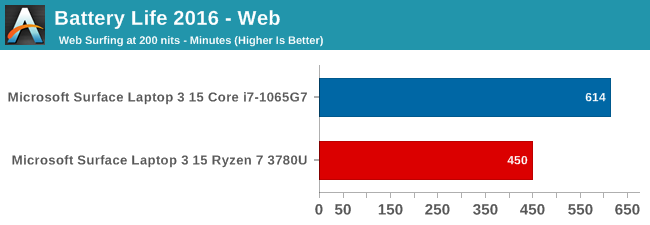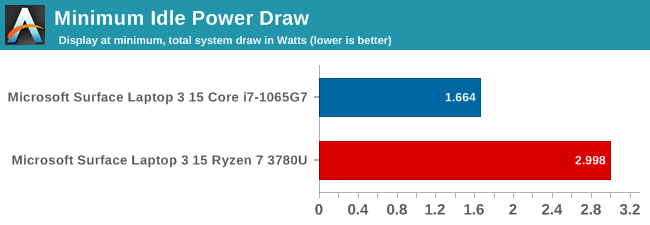The Microsoft Surface Laptop 3 Showdown: AMD's Ryzen Picasso vs. Intel's Ice Lake
by Brett Howse & Andrei Frumusanu on December 13, 2019 8:30 AM ESTPlatform Power
Performance aside, the other side of the coin is battery life. AMD made big gains in battery life with the Ryzen 3000 series, somewhat addressing the power requirements of the platform and getting rid of some of the excessive idle power draw, but they are still using DDR4 on their mobile platform, which puts them at a disadvantage right out of the gate. Intel has made very good gains in battery life over the last several generations, and the move to 10 nm for Ice Lake also brought along LPDDR4X support. Most of the previous generation laptops stuck with LPDDR3, unless the manufacturer needed more than 16 GB of RAM, where they’d be forced to switch to DDR4. Finally adding LPDDR4X support is something that Intel has needed to do for a while, and ironically Intel’s flagship Core product line lagged behind their low-cost Atom lineup which did support LPDDR4.
Web Battery Life

The Ryzen 7 3780U powered Surface Laptop 3 was slightly under the Ryzen 5 device we tested at launch, but still in the same range. The AMD system isn’t helped very much by Microsoft only offering a 46 Wh nominal battery capacity, which is rather undersized for a 15-inch laptop. The Ice Lake device, as we’ve seen before, was much more efficient under load, offering a sizeable battery life lead.
Idle Power
One of AMD’s biggest challenges was to get their laptop SoC into a premium device, and with the Surface Laptop 3 they have succeeded. Microsoft has shown themselves as being adept at squeezing battery life out of devices, with low-power displays, and good internal components to minimize power draw. Here Intel has held a considerable advantage over the last couple of years, and the move to 10 nm should, in theory, help as well.
To test the idle power draw of both systems, the battery discharge rate was monitored with the screens fixed in at 5.35 nits, to minimize the power draw of the display on the result. Normally we’d prefer to have the display completely off for this test, but Microsoft’s power plan on the Surface Laptop actively turns off the laptop when the display times out.

The Ice Lake system was able to go all the way down to right around 2 Watts of power draw – and sometimes slightly under – with as low as 1.7 Watts seen. We’ve seen under 1 Watt of draw on an 8th generation Core Y series processor, and around 1.5 Watts on the same generation U series, so considering the display is not completely off on the Surface Laptop, the 2-Watt draw is quite reasonable.
The Picasso system was not quite as efficient, drawing 3 Watts at idle. This is in-line with the results we’ve seen on other Picasso systems and explains the lower battery life results on the AMD system. AMD made big gains moving from Raven Ridge to Picasso, but I’m sure the team is looking forward to the 7 nm Zen 2 coming to their laptops, which we hope will address this further.










174 Comments
View All Comments
Korguz - Friday, December 20, 2019 - link
HStewart.. and yet to STILL believe the lies intel tells you.. that is why you are thought of as an intel fanboy... until intel delivers on what they claim, and actually have products out, and no, the limited products on 10nm, that max out at quad core and lower frequencies then 14, does NOT count, anything they say, should be treated as BS...going by your post.. you have NO proof of your claims... and they are in fact, just your opinions...
MBarton - Monday, December 30, 2019 - link
At this point Intel's roadmaps are nothing more than lip service for investors. Absolutely nobody takes them seriously.djayjp - Friday, December 13, 2019 - link
AMD should've led Zen 2 (third gen Ryzen) with mobile first. Oh well maybe next generation.djayjp - Friday, December 13, 2019 - link
Also the marketing name for the chips really doesn't help, in fact I think it works against them and makes them look bad.ChubChub - Sunday, December 15, 2019 - link
Absolutely this. A friend's 6600k just died, and wanted to go with AMD. I'm up to date with most computer stuff, so he asked my opinion.He was thinking a 3400g,because APU + 3rd gen Ryzen. It was weird to tell him that AMD stupidly named the 1st gen APUs with the 2nd gen nomenclature … then continued this stupidity for no reason. All chips 1xxx are Zen, all 2xxx chips are Zen+, all 3xxx chips are ZEN 2 … well, except the APUs, which are all back a generation.
I have high hopes for the 4xxx APUs; would be nice if they fixed the naming by pushing them back to 3xxx. However, even better would be Zen 3 cores in mobile; 4xxx naming would then make sense, they could get some volume out on the 7nm+ process that already works, use ASMedia/VIAs new higher efficiency chipset slated for Zen 3, and they'd likely decidedly obliterate Intel's offerings on CPU and GPU performance (probably not on power though; Intel is doing some good stuff there). One can dream.
MikhailT - Friday, December 13, 2019 - link
I disagree, AMD is winning over a lot of the big businesses with their EPYC chips. They need the cash more than they need laptop revenue at the moment and 7nm capacity is very limited. It's best to start with the highest-profit maker first.Get the business on their side, get more money to grow their team and then they'd be able to do more stuff at the same time like Mobile, Server, Desktop, Gaming, and so on.
All this means is that we can hope to look forward to see what Surface Laptop 4 can do with AMD's Zen 2 chips when it comes out next year.
MBarton - Monday, December 30, 2019 - link
Why? So AMD can delay their most valuable products (Epyc and Threadripper) so they can attempt to make some low margin mobile sales? Ridiculous. Mobile is one area that Intel is still fairly competitive in. There's no reason to give up high margin markets where AMD has a strong advantage, for a market where AMD would be forced to compete head on with Intel 10nm for low margin sales.Fataliity - Friday, December 13, 2019 - link
It is interesting how you did the test. I understand ur playing at "Value" because its a laptop. But if its getting 100FPS why couldn't you turn up the graphics a bit to get around 60, to show what people should expect? Because at "Value" you are purposelly making the 18% IPC affect the FPS in the situation (720p is "CPU Bound" at low)...I also noticed you used alot of "real world" names for your cpu tests, even synthetics. While the gpu synthetics you just called "gpu tests"...
... You put the Ice Lake system in the best possible light is what I"m saying. Gave it every advantage. Why?
Lord of the Bored - Saturday, December 14, 2019 - link
Because it is the thirteenth. They are wildly and insanely obviously in the pocket of Intel on odd days. Come back on an even day if you want an AMD-biased test, because those are the days AMD bought.Brett Howse - Saturday, December 14, 2019 - link
Because we use the data for future articles:https://www.anandtech.com/bench/Notebook/725
If I run at random settings then the data isn't useful for the future.
Also if anything the AMD system was put in the best light because it was running at 1280x720 instead of 1366x768, as mentioned in the article.